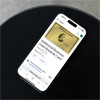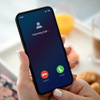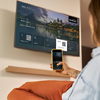Sit down in front of your computer, but don't turn it on yet. Cover your eyes so you can't see anything; don't cheat, and don't peek! Now, turn on your computer, if you can find the switch, which, hopefully, you can from memory, right? Now, try doing something on your computer after it has booted up. Open your browser and read the latest news on CNN.com. Check your email in Outlook.
Darn near impossible, right? But not for me.
My name is Marcia Ilene Baran and I have been totally blind since birth. Yet, with blind/accessible technology, I can do everything I need to on a computer, including writing the story you’re reading right now.
My Journey
I was a Social Worker for twenty years and now I dedicate my life to giving back to society as the volunteer coordinator for the Library for the Blind and Physically Handicapped in Rocky Hill, Connecticut.
Yet it was only four years ago that I decided to become computer educated. I kept hearing advertisements on television to go to this and this web site to read about this and this topic. I had a vague notion of what a computer could do, but I realized that I was not in the loop, and that I'd better do something about it, really fast. I began researching technology schools for the blind throughout the United States, and chose Blind & Vision Rehabilitation Services of Pittsburgh, where all the instructors where blind, as well.
When I first got to school, I literally knew nothing about computers. I didn't even know what a cursor was or how it worked. To help me learn to navigate, the instructor would insert a disc into the computer with jumbled up words and sentences. My assignment was to correct and arrange them so that they were readable and made sense.
Soon, I was sending my first email. I was so overjoyed that I let out a scream of joy and then started to cry. The whole school came running, and everyone wanted to know what happened. I just sent my first email successfully; this was a living miracle!!
When I was relatively new to the computer, I was like a kid in a candy store! I would find lists and lists of free email newsletters that I could receive. I was so excited by the whole prospect, in general, that I signed up for everything in sight! My inbox became overloaded – I was on my way to becoming an email junkie! I quickly learned to become more discriminating in my selections. Now I subscribe to “only” 63 newsletter emails ranging from perfume to music to computer technology.
I also learned that email was not the impersonal version of a telephone call. I would write a friend in California – who had been extremely ill for three years before she passed away – at least ten emails every day, encouraging her, letting her know how much I loved and respected her, etc. Before she died, she wrote and told me how much she depended upon my daily emails for strength and courage!
Computer accessibility has enabled me to search the web extensively, pursuing in-depth information on topics I am interested in. I participate in an online community bulletin board that specializes in music, one of my greatest loves, and I browse Amazon and other shopping web sites to view their merchandise. I can't do my own purchasing yet, however, because it is extremely difficult if you are blind, so my friends do it for me.
The history of computer tools for the blind
My computer skills and abilities are increasing every day, because I am constantly educating myself to learn more. But I could never accomplish what I have without the tools specifically created for the blind and visually impaired.
When I was attending college at the University of Hartford, earning my B.S. Degree in Secondary Education and a minor in Spanish, I would have to first put my term papers into Braille, and then type them on a regular typewriter. However, if you are blind, you can't correct your errors. Many times I would make no mistakes until the very bottom of the page. Then, I had to type the whole page all over again.
According to Michael Hingson, a leading authority on the advances in adaptive technology (and visually impaired, himself), "Forty years ago…there was no general attempt by industry or the college world to create a device which reading/disabled individuals could use. Those devices which did exist in the early and mid-seventies were primarily expensive hardware-based technology, as computers had not progressed to the extent where technology to create alternatives to print and video displays could reside within the computers themselves nor their programming. One Braille producing computer terminal, for example, consisted of a modified teletype printer and a PDP-8E minicomputer solely to drive it.”
Even well into the eighties, those who wished to hear what was being displayed on the computer screens needed to purchase a separate hardware devices. But we began to see the emergence of primitive software which resided directly on your computer and could create synthesized speech as an alternative to sight-oriented video displays.
By the early nineties, the processing of computers finally reached the point where screen reading technology could provide blind and other print disabled persons the opportunity to have a real shot at using computers at school, on the job, and at home, just like their sighted colleagues and friends. Even so, only a few specialized companies stepped forward to manufacture the technology, and the cost for the screen reading software was sometimes greater than the price of the computer itself.
Today, I use a program called Dolphin Guide, which reads out loud to me, in the most beautiful, human-sounding voice you could ever imagine. Using voice commands, I can read and write emails; organize my email into folders; search the web; keep an address book; manage my calendar; scan and read a book, magazine and some hand-written notes; play CDs and DVDs; and even read labels on bottles. And this is only a partial list of everything it allows me to do on my computer.
And unlike my student days at the University of Hartford, now, I can type with perfect ease. Now, guess what my two most favorite keys are on the computer? Spellcheck and delete! What a feeling of total freedom and empowerment!
According to Laura Mills of Evas.com, distributors of Dolphin Guide in the United States, "An engineer in the U.K. originally designed Guide for his elderly relative who had degenerative eye disease and wanted to access email on the web. Once he saw how helpful it was for his relative, he began building the program for the consumer market and it grew from there.”
Obviously, access technology for the blind and visually impaired has come a very long way. All of the companies producing accessible technologies are constantly improving, updating, and producing new versions of their software.
And Web accessibility of web sites is constantly evolving, as well. The National Federation of the Blind is happy to assist any company or individual with making on-line content accessible to blind computer users. In most cases, a complete redesign of a web site is not necessary in order to make it accessible.















From Alicia on June 22, 2012 :: 12:53 pm
What an inspiration! I really enjoyed reading this article. Kudos to Techlicious for posting it and even more kudos to Marcia for her fortitude and perseverance in learning how to become computer savvy. As a former software instructor, I know how hard it can be to translate the concept of technology. Thanks again for such a positive read!
Reply